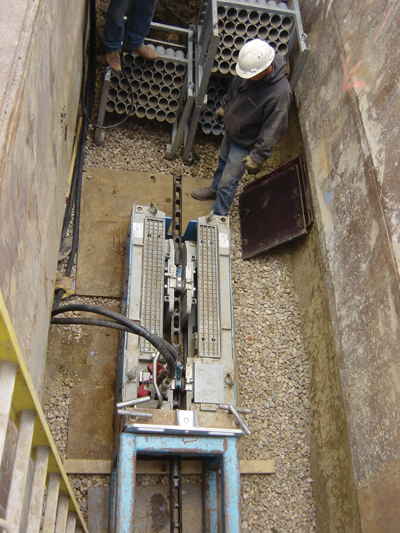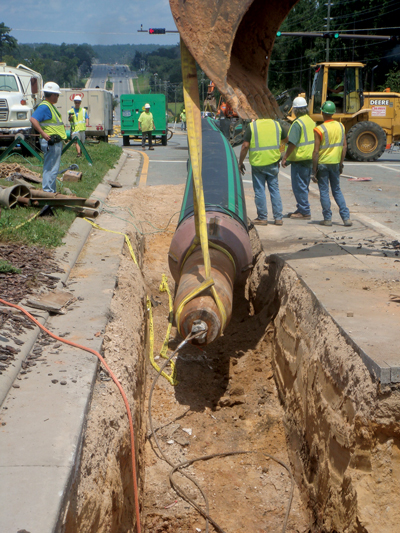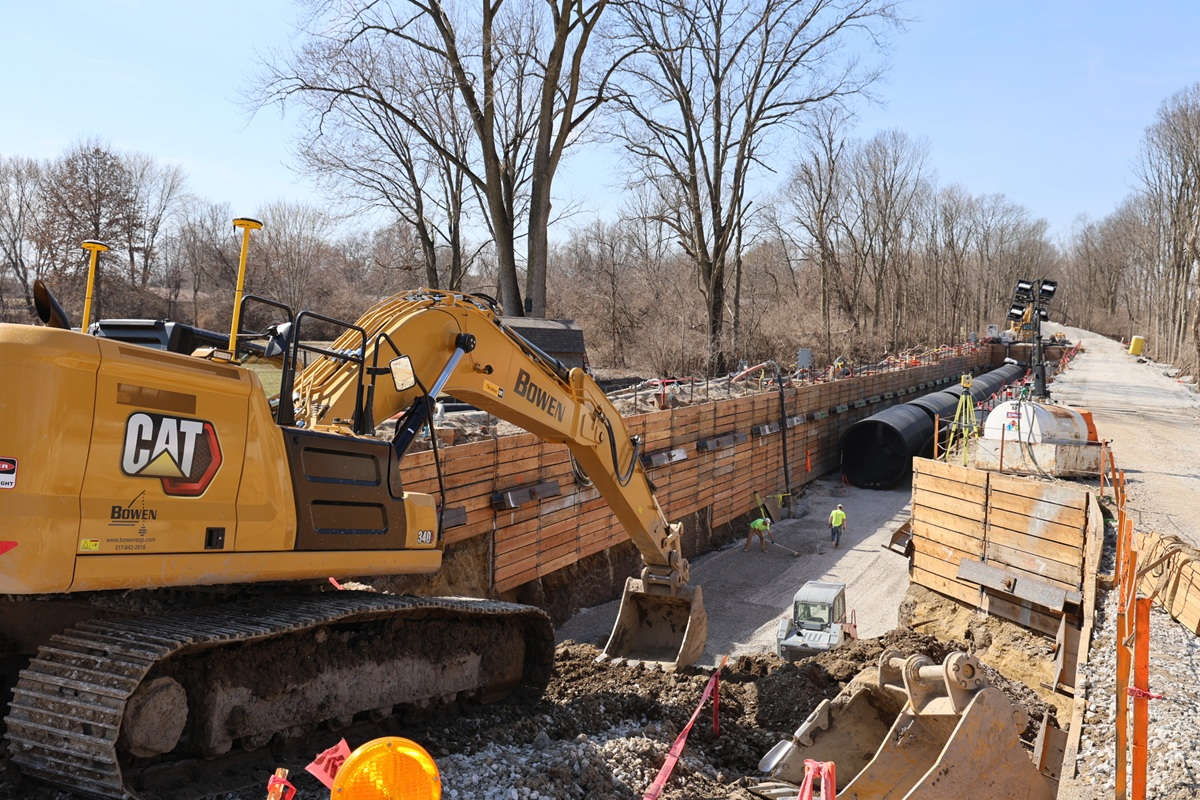Staying Strong
 Since its introduction to North America more than 30 years ago, pipe bursting is still making a tremendous impact on the way sewer, water, gas and storm drain pipe replacement is done. Pneumatic pipe bursting was developed from the concepts found in pneumatic piercing tools and still makes up the largest portion of high production bursting that is done in the United States. Over the last 20 years, the static pipe bursting method has become one of the most utilized and preferred trenchless methods as well. Each method offers distinct benefits and each has earned its place in the trenchless construction toolbox.
Since its introduction to North America more than 30 years ago, pipe bursting is still making a tremendous impact on the way sewer, water, gas and storm drain pipe replacement is done. Pneumatic pipe bursting was developed from the concepts found in pneumatic piercing tools and still makes up the largest portion of high production bursting that is done in the United States. Over the last 20 years, the static pipe bursting method has become one of the most utilized and preferred trenchless methods as well. Each method offers distinct benefits and each has earned its place in the trenchless construction toolbox.
Pneumatic Pipe Bursting Overview
During pneumatic pipe bursting, the pipe bursting tool is guided through a fracturable host pipe by a constant tension winch. As the tool travels through the pipe, its percussive action effectively breaks apart the old pipe and displaces the fragments into the surrounding soil. Depending on the specific situation, the tool is equipped with an expander, which displaces the host pipe fragments and makes room for the new pipe. As the tool makes its way through the host pipe, it simultaneously pulls in the new pipe, usually HDPE.
This process has remained relatively true to its original state. The size and power of the tools have increased over the years, and their process capabilities have become more defined, but the basic operation remained, in essence, the same. Pipe sizes up to 54 in. in diameter have been installed.
Static Pipe Bursting Overview
During the static bursting process, specially designed bladed rollers are pulled through an existing line, attached to bursting rods, by a hydraulically-powered bursting unit. As the bladed rollers are pulled through, they split the host pipe. An expander attached to the rollers forces the fragmented pipe into the surrounding soil while simultaneously pulling in the new pipe.
Preferable bursting rods are linked, not screwed together like traditional drill stems. This system plays a large role in the use of various product pipe materials and speeds the installation process as well as the breakdown procedure. The rods can be quickly removed one at a time at the exit pit as bursting is in operation. When splitting steel pipe and ductile iron pipe, a bladed roller configuration is an essential part of static bursting success. The specially designed bladed rollers actually split the host pipe instead of ripping or tearing it. This is a clean process that eliminates sharp edges and prevents potential damage to the new product pipe.
 Static systems have evolved greatly. Pipe sizes up to 36 in. in diameter have been installed. They have become more versatile as pipe manufacturers and equipment manufacturers have teamed up to develop new techniques for installing product pipes and developed new cutting head systems for replacing a wide range of host pipe materials, including ductile iron and steel. New pipe materials include HDPE, fusible PVC, restrained joint PVC and restrained joint ductile iron pipe (restrained joint DIP) for gravity and pressure applications.
Static systems have evolved greatly. Pipe sizes up to 36 in. in diameter have been installed. They have become more versatile as pipe manufacturers and equipment manufacturers have teamed up to develop new techniques for installing product pipes and developed new cutting head systems for replacing a wide range of host pipe materials, including ductile iron and steel. New pipe materials include HDPE, fusible PVC, restrained joint PVC and restrained joint ductile iron pipe (restrained joint DIP) for gravity and pressure applications.
Choosing a System
The real place to start specifying bursting equipment has to be on the ground. What kind of work is being done, where is it being done, what is the host pipe, what are the ground conditions and what are the expectations? All of these are determining factors to what kind of equipment to use. Each job is different, and each job requires a specific level of evaluation to be completed in order to get the right equipment in place.
It’s best to evaluate pipe bursts on a job-by-job basis. Each job has unique characteristics and situations that have to be taken into consideration before a burst is attempted. A good way to ensure a successful burst is to identify potential problems and remedy them before bursting. The following are primary considerations:
Host pipe. Fracturable host pipes include concrete, reinforced concrete, clay, cast iron and ACP, and are well suited for pneumatic pipe bursting. PVC and other plastics are routinely split or burst; either pneumatic or static systems can be used. With PVC and other plastics, special cutting blades are necessary. Ductile iron and steel also require special consideration, as does the size of the host pipe.
Jobsite layout. No matter which method is utilized, consideration must be given to the layout of the worksite. Some jobs require both a launch and exit pit. Other jobs are manhole launched and removed. Still, other jobs burst from a launch pit to a manhole.
Required burst length. In most sewer replacement applications, the burst length is usually manhole to manhole. Long bursts with large-diameter product pipes may require bigger tools and the addition of lubrication for the new pipe using polymer or bentonite mud mix.
Terrain and soil conditions. Most favorable bursting projects involve pipes that were originally installed by trenching or open cut because the fill material surrounding them is usually conducive to pipe bursting. Knowledge of the existing soil conditions is important. Depth of cover also needs to be considered. Without good soils knowledge, some jobs may prove to be more than difficult. There is no substitute for a good soils report. Some soils in pipe bursting situations, like running sand, will not remain in the expanded state long enough due to pipe drag for the installation of new product pipe.
Product pipe type and size. Tool and expander configurations with pneumatic systems and cutting and bursting head sizes for static systems are influenced by product pipe size. HDPE is the most common new pipe material, and it is used almost exclusively for pneumatic bursting operations. Static pipe bursting, however, provides users more choices in the types of product pipe that can be installed.
Various pipe manufacturers have been working with pipe bursting equipment manufacturers to find real-world ways to adapt their pipe products to pipe bursting installations. Segmented pipe is now being installed at ever-increasing rates through static pipe bursting.
These pipes are assembled one joint at a time in a “cartridge loading” process. It is described this way because of the similarities between a rifle cartridge providing bullets to the rifle chamber and the segmented pipes being lowered and assembled in the launch pit. It is well suited for locations where available space for pipe lay down is not available.
Segmented or sectional pipe can be roughly placed into two categories, restrained joint and non-restrained joint. Each type requires a different approach when used in conjunction with static bursting. Installing sectional pipes with restrained joints through static pipe bursting requires a specific bursting head to connect to the product pipe and then to the static pipe bursting tooling. Nothing additional is required. Subsequent sections of the restrained joint pipe are assembled during the bursting process as the pipe string progresses. Pulling new restrained joint DIP or restrained joint PVC is now a routine installation.
Sectional pipe with non-restrained joints, however, requires a slightly different approach. Because the joints are not restrained, something needs to push them together and then hold the assembled pipe sections in compression as they are installed. Quicklock style bursting rods and a specially designed cylinder pack provide the solution. The bursting rods are connected from the back end of the bursting head and extend through each section of the sectional pipe. As a new section of pipe is added to the pipe string, the cylinder pack and pressure plate, connected to the column of bursting rods, push the pipe joints together. The pressure plate and cylinder pack then hold the string of assembled pipe sections together, in compression, while the bursting head is pulled forward through the old pipe. Once that section of pipe is installed, the bursting process stops, the cylinder pack and pressure plate are withdrawn and the process repeats.
Right Tools for the Job
Another consideration that has come to light in recent years concerns the ability of the equipment to handle the job. This is an issue beyond choosing static or pneumatic pipe bursting; this is an issue about choosing qualified equipment, backed by experience and technical support. The methods have been around long enough now that many different versions of pipe bursting equipment are available. Some would fall under the category of “homemade.” Some are being sold to contractors without any technical support, background or established track record of project success to draw from. Underground utility construction work is dangerous. It is more dangerous with equipment that is poorly designed, poorly maintained and poorly supported.
Do not fall into the trap of price point buying. All too often price becomes the single driving factor in equipment purchases, and it can’t always be that way. Price is part of the equation, but issues like quality, safety, capability and experience need to be factors as well. Evaluate equipment on its merits, how well it will perform on the job and how safe it is to use. There is too much a stake to simply buy cheap.
Collins Orton is a Pipe Bursting Specialist for TT Technologies.




